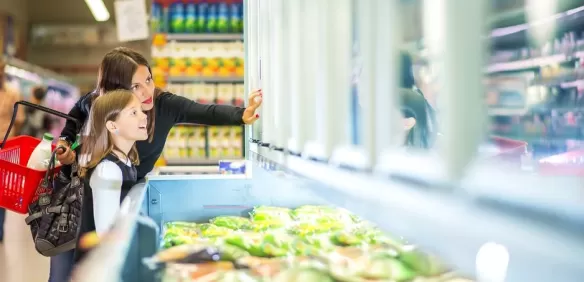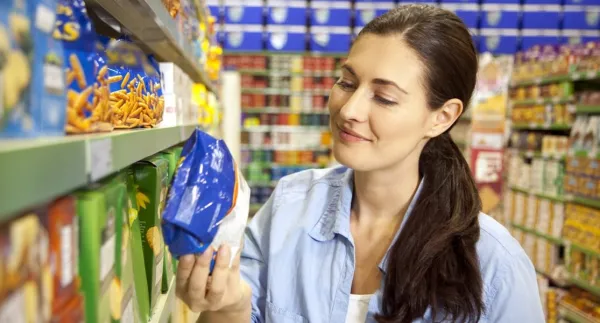
What does “packaged in a protective atmosphere” mean on certain food packaging labels?
Foods packaged in a protective atmosphere (MAP) are foodstuffs whose durability has been extended by packaging gases authorized under Regulation (EC) No. 1333/2008.
As consumers, we want to be informed about the composition of the food products we buy, whether for nutritional reasons, allergies, weight and price, or even shelf life.
When we go shopping, we buy:
- Ultra fresh products, with a very short consumption date of a few days and which must be stored between 0 and +6°C,
- Pre-packaged products, that is to say foods put in packaging before being presented for sale. These foods, packaged in suitable conditions, have the advantage of retaining their freshness, taste and nutritional quality over a longer shelf life defined by the manufacturer.
So that we are perfectly informed of what we are buying, these foodstuffs presented for sale must offer clear and precise, regulatory labeling.
What are the labeling rules for prepackaged foods?
It is European Regulation (EU) No. 1169/2011 which sets the rules for informing consumers about foodstuffs, regardless of their method of packaging or presentation (pre-packaged or not).
Among the mandatory information that must appear on prepackaged products, we find, for example:
- the sales name,
- the list of ingredients,
- the weight,
- the manufacturing batch number,
- the name of the company,
But other additional mandatory information may appear on the labeling of prepackaged foodstuffs, including the mention “Packaged in a protective atmosphere”.
What is food packaged in a protective atmosphere?
Foods packaged in a protective atmosphere are foodstuffs whose durability has been extended by packaging gases authorized under Regulation (EC) No. 1333/2008.
Certain foodstuffs are in fact very perishable (raw meat or fish for example) and can only be kept for a few days. In order to extend their shelf life, manufacturers use the technique of “protective atmosphere packaging” also called “modified atmosphere packaging” or “MAP” for “Modified Atmosphere Packaging”.
Protective atmosphere packaging (MAP) consists of replacing the air inside a package with a gas (or a mixture of gases) with protective properties. Indeed, as soon as they come into contact with air, foods undergo deterioration which affects their color, appearance, texture, taste and shelf life. Packaging in a protective atmosphere helps preserve the appearance, color and organoleptic properties of the product during its shelf life. It limits the growth of bacteria and slows down biochemical degradation.
A longer shelf life is therefore associated with the term “packaged in a protective atmosphere”. It is determined by the manufacturer using aging tests or the results of microbiological analyzes and linked to storage conditions, particularly temperature. We speak of DLC (Expiration Date) or MDD (Minimum Durability Date).
A large number of products are packaged in a protective atmosphere: products with high humidity (beef, poultry, fish, seafood, etc.), products with intermediate humidity (charcuterie products), or even dry products (breads, pastries, dried fruits, etc.).
The MAP technique requires real know-how. It is in fact necessary to choose the packaging film appropriate to the food to be packaged (e.g. meat or fruits and vegetables, etc.), the packaging machine and finally the gas (nitrogen, carbon dioxide, oxygen, etc.). With implementation in perfect hygienic conditions, the food safety of the product will be ensured.
After opening, the gas escapes and the products packaged in a protective atmosphere are no longer protected. They must be consumed within the time limits indicated on the label.
Fresh products must be stored in the refrigerator. If a package turns out to be defective, bulging for example, or if it presents a particular odor when opened, it must not be consumed even if the shelf life has not been reached.
To carry out modified atmosphere packaging in the best conditions, our experts are at your disposal. They will provide you with all the advice on the gas mixture to choose, the films or packaging machines adapted to your needs, as well as on the conditions for using the gas.
Do you have any questions about the terminology “Packaged in a protective atmosphere”? Please fill out our contact form.
Our experts will respond to you within 24 hours
Frequently asked questions
How to increase the shelf life of products?
What does “packaged in a protective atmosphere” mean on certain food packaging labels?
What are the different packaging machines for M.A.P?
What installation do I need to use gas?
What modified atmosphere for the conservation of fresh meats?
What modified atmosphere for bakery products?
What modified atmosphere for the conservation of seafood products?
What modified atmosphere for the conservation of cheese and dairy products?
What modified atmosphere for dry products?
What modified atmosphere for the conservation of prepared fruits and vegetables?
